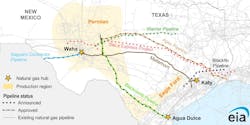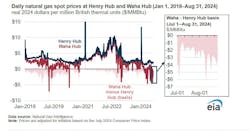Permian basin natural gas pipeline capacity set to increase
Natural gas pipeline takeaway capacity in the Permian basin will soon increase as the 2.5 bcfd Matterhorn Express Pipeline is expected to begin service this month, the Energy Information Administration (EIA) said in a report, citing EnLink Midstream, a stakeholder in the pipeline project.
Matterhorn, a joint venture of EnLink, Whitewater, Devon Energy, and MPLX, will transport natural gas from the Permian basin to Katy near Houston, Tex. Since 2018, natural gas production from the Permian basin has more than doubled mainly due to associated gas from increasing oil production, leading to a drop in regional spot natural gas prices and spurring higher demand for new pipeline takeaway capacity to transport the gas to more viable markets, EIA said.
In addition to Matterhorn, three new Permian basin pipeline projects with a combined capacity of 7.3 bcfd have been approved and are in various stages of development:
- Apex Pipeline, with a capacity of 2.0 bcfd, is designed to transport natural gas from the Permian basin to Port Arthur, Tex. Operator Targa Resources expects the pipeline to enter service in 2026.
- Blackcomb Pipeline, with a capacity of 2.5 bcfd, is designed to transport natural gas from the Permian basin to Agua Dulce in south Texas. Operator Whitewater Midstream expects the pipeline to enter service in 2026.
- Saguaro Connector Pipeline, with a capacity of 2.8 bcfd, is designed to transport natural gas from the Permian basin to the US-Mexico border. EIA expects the pipeline, which connects with the Sierra Madre pipeline on the Mexico side, to enter service by 2027–28.
Pipeline operators have announced other projects with a total capacity of 7.0 bcfd designed to transport natural gas from the Permian basin to demand centers in Mexico and along the Texas Gulf Coast. These projects, if realized, could come into service between 2025 and 2028, the EIA said.
Price differentials
When regional growth in natural gas production outpaces pipeline takeaway capacity additions, capacity constraints exert downward pressure on spot natural gas prices at the Waha Hub, which is near Permian basin production.
Prices at the Waha Hub have been below zero for 46% of trading days in 2024, including every day since July 26, according to data from Natural Gas Intelligence. The lowest price recorded at the Waha Hub this year was -$6.4/MMbtu on Aug. 29.
“The price difference between the Waha Hub and the US benchmark Henry Hub widens under constrained pipeline conditions and narrows as those constraints ease. So far in 2024, the Waha Hub spot price has traded an average $2.07 below the Henry Hub price, compared with an average ₵42 below the Henry Hub price in second-half 2021. The takeaway capacity added when the Matterhorn pipeline enters service should allow producers to increase deliveries of natural gas out of the Permian Basin and help to increase the natural gas price at the Waha Hub, making its price difference to the Henry Hub less negative or even positive,” EIA said.

